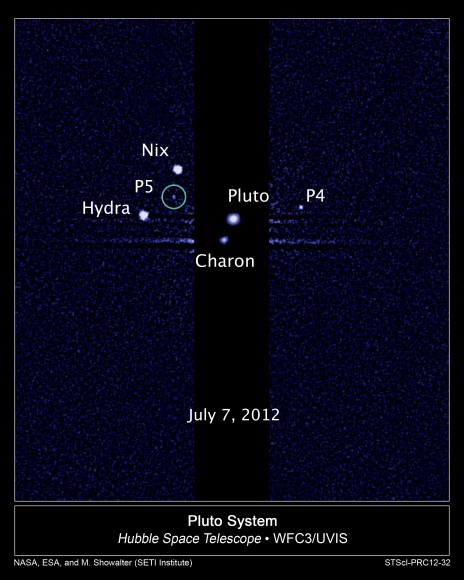Alan Stern, chief scientist of the New Horizons mission, reports another moon, the fifth of the number discovered around the dwarf planet Pluto

Alan Stern, the chief scientist of the New Horizons mission, reports another moon, the fifth of the number discovered around Pluto.
As you remember, Pluto is a dwarf planet, but that doesn't disqualify it from having moons. After all, even certain asteroids have moons. How these moons were formed is the interesting question: were they formed from within Pluto by the crash of another large object onto Pluto when the solar system was younger, or were they formed elsewhere and captured by its gravity? New Horizons will try to find evidence that will help us find answers.
Pluto has been known to us since 1930 in total, because its tiny diameter and great distance from the Sun made it difficult to locate it. The moon Charon was only discovered in 1978, and its diameter is about half the diameter of Pluto, meaning a huge moon in relation to the body around which it orbits. This was the case until the last decade, when some important things happened related to Pluto.
First, in 2005 two small moons were discovered in addition to Charon. They are between 30 and 100 km in diameter, and they were given the nicknames Nix and Hydra, both of which are much farther from Pluto than the moon Charon. Uncertainty about their size will be reduced, it must be assumed, when they are imaged with the instruments of New Horizons.
Second, in January 2006, the New Horizons spacecraft was launched, which will make a close pass to Pluto and its moons in three years.
In 2006, the convention of the International Astronomical Union also took place where it was decided to reclassify Pluto as a dwarf planet, a correct decision in my opinion.
A year ago, in July 2011, I published an entry in honor of the discovery of a fourth moon to Pluto, called P4 in the meantime, or S/2011P1, until it is given an official name. P4 is a really small moon, and its diameter is probably between 15 and 30 km only.
Today we received as a surprise another member of the Pluto family, whose temporary name is P5. According to Stern, it is even smaller than its predecessor.
It amazes me that you can even see such small things from such great distances, but it turns out that you can!
For previous information on the subject:
Hubble discovered Pluto's fourth moon
Pluto and its moons - summary for 2010 (then known only as Charon and two of the small moons)
The article was first published on Yoav Landsman's blog Critical Essay

3 תגובות
Another reason to wait for the arrival of New Horizons to Pluto.
It will be interesting to finally see what it looks like and how many moons it really has (if by now moons have been discovered then there is no reason why they won't discover more by the time New Horizons arrives)